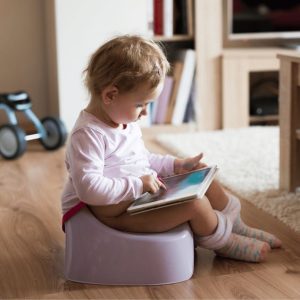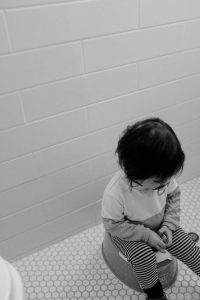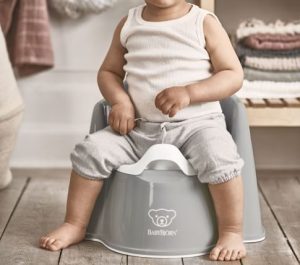Potty training is a big milestone for both toddlers and parents. It can be a messy and frustrating journey, but also an exciting time of independence and growth. Pull-up diapers can be a helpful tool during potty training. Here’s a guide to using pull-ups effectively.
What are Pull-Ups?
Pull-ups are disposable training pants that look and feel more like underwear than diapers. They come in various sizes and designs featuring cartoon characters. Pull-ups absorb wetness, but they are not as absorbent as diapers. This can help toddlers feel the sensation of being wet, which can encourage them to use the potty.
When to Introduce Pull-Ups
There’s no one-size-fits-all answer to this question. Every toddler develops at their own pace. However, some signs might indicate your toddler is ready for pull-ups:
Shows interest in the potty:
Does your toddler seem curious about the toilet? Maybe they like to watch you use it or pretend to use a toy potty?
Stays dry for longer stretches:
Can your toddler stay dry in their diaper for two or more hours?
Communicates potty needs:
Does your toddler use words or gestures to communicate when they need a diaper change?

Using Pull-Ups Effectively
Here are some tips for using pull-ups during potty training:
- Pair with potty time: Make using the potty a regular part of your toddler’s routine. Sit them on the potty for a few minutes after waking up, nap time, and before bed. Even if they don’t go, it helps them get used to the idea.
- Accidents happen: Wet or soiled pull-ups are a normal part of potty training. Stay calm, clean up the mess together, and gently remind your toddler about using the potty.
- Positive reinforcement: Praise your toddler for using the potty, even for small successes like sitting on it or telling you they need to go.
- Be patient: Potty training takes time. Avoid getting discouraged or frustrated. Celebrate every milestone, no matter how small.
Benefits of Pull-Ups
Pull-ups can offer several benefits during potty training:
- Sense of independence: Pull-ups look and feel more like underwear, which can give toddlers a sense of independence and control.
- Feeling wetness: Unlike diapers, pull-ups don’t completely absorb wetness. This can help toddlers associate the feeling of being wet with using the potty.
- Easy to pull up and down: Pull-ups are easier for toddlers to pull up and down than diapers, encouraging self-care skills.

Beyond Pull-Ups
Pull-ups are a helpful tool, but they are not a magic solution. Here are some additional tips for successful potty training:
- Make it fun: Use colorful potty chairs, sticker charts, or sing potty songs to make potty time more enjoyable.
- Lead by example: Let your toddler see you using the potty. Talk openly about what you’re doing.
- Invest in a potty chair: Choose a potty chair that’s the right size for your toddler. Let them pick it out if possible.
- Be consistent: Stick to a regular potty routine and don’t give up easily.
Remember
Potty training is a journey, not a race. Every toddler learns at their own pace. Be patient, celebrate successes, and use pull-ups as a helpful tool along the way.
Common Potty Training Challenges
Potty training isn’t always smooth sailing. Here are some common challenges you might face:
- Accidents: Accidents are inevitable during potty training. Stay calm, clean up the mess together, and gently remind your toddler about using the potty.
- Resistance: Some toddlers may resist using the potty. Avoid pressuring them. This can make them more resistant. Take a break from potty training for a few weeks and try again later.
- Fear of the toilet: Some toddlers may be afraid of the toilet. Use a potty chair sized for them and make potty time positive and relaxed.
Tips for Addressing Challenges
Here are some tips for addressing common potty training challenges:
- Be patient and consistent: Potty training takes time. Stick to a routine and avoid getting discouraged.
- Positive reinforcement: Praise your toddler for using the potty, even for small successes.
- Make it fun: Use colorful potty chairs, sticker charts, or sing potty songs to make potty time more enjoyable.
- Talk to your pediatrician: If you have concerns about your toddler’s potty training progress, talk to your doctor.
Pull-Ups: A Gradual Step
Pull-ups can be a helpful step on the way to using underwear. Here’s how to think about them:
- Transition from diapers: Pull-ups can be a way to gradually transition toddlers from diapers to underwear.
- Not a replacement for underwear: The goal of potty training is to use underwear. Pull-ups can be a helpful step along the way, but not a replacement.
- Nighttime wear: Pull-ups can be a good option for nighttime wear during potty training.
When to Consider Underwear
There’s no right or wrong time to switch from pull-ups to underwear. Here are some signs your toddler might be ready:
- Stays dry overnight: Can your toddler consistently stay dry throughout the night?
- Has few daytime accidents: Are accidents becoming less frequent during the day?
- Expresses interest in underwear: Does your toddler show interest in wearing underwear like grown-ups?
Potty Training Essentials
Here are some essential items to have on hand during potty training with pull-ups:
- Pull-up diapers: Choose a good quality pull-up that fits your toddler snugly without being too tight.
- Potty chair: Select a potty chair that’s the right size for your toddler. Consider features like a removable insert for easy cleaning and fun designs.
- Waterproof mats: Place waterproof mats under the potty chair to protect floors from accidents.
- Easy-to-wash clothes: Stock up on clothes that are easy to take off and put on, like loose-fitting pants and skirts. Accidents happen, so be prepared for laundry.
- Positive reinforcement tools: Have stickers, a sticker chart, or small toys on hand to reward your toddler for potty successes.
Potty Training Books and Apps
There are many potty training books and apps available. These resources can provide helpful tips and strategies, and some can even make potty training more fun for toddlers. Here are some things to consider when choosing potty training resources:
- Age-appropriateness: Make sure the book or app is designed for your toddler’s age and developmental level.
- Positive approach: Look for resources that use positive reinforcement and avoid shaming or punishment.
- Engaging content: Choose a book or app with colorful illustrations, catchy songs, or interactive features to keep your toddler engaged.








